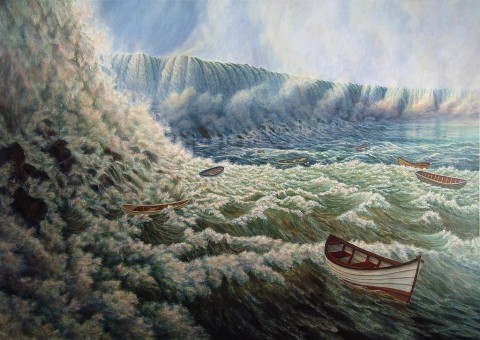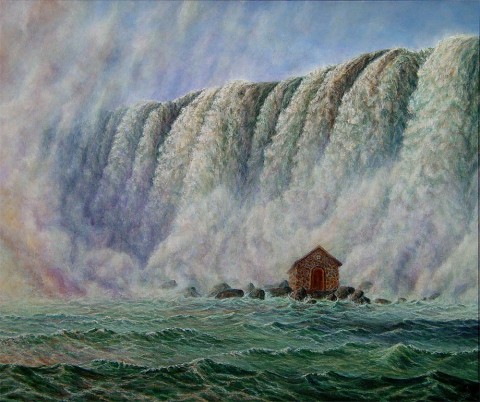Art: Acrylic Wash Acrylics Painting Techniques Watercolor Paper Waterfall
by David Jay Spyker
leave a comment
A Waterfall Study, Acrylics On Paper
I have been using Golden Paints’ Open Acrylics line of paints now for a while, and because of the extended working, or “open” time of the product, I thought I would try them on paper in a watercolor style. The finished piece is a nice little interpretation of Niagara Falls.
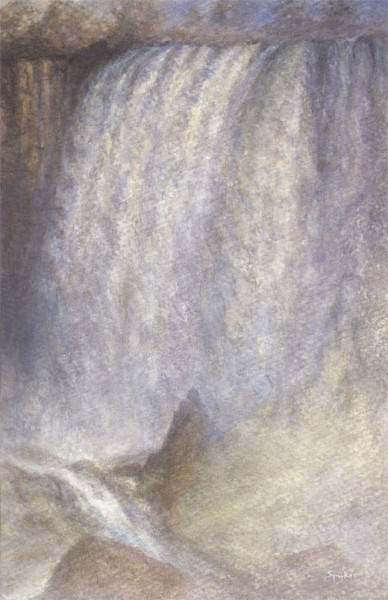
"Niagara", 2009, by David Jay Spyker - 5.5 x 8.5 inches - Acrylic Wash, Minor Drybrushing, and Paint on 100% Cotton Cold Press Watercolor Paper
The bulk of the painting was done on slightly damp to wet paper, but included some minor drybrushing, and some basic acrylic paint layering (particularly with whites and cobalt-tinted whites to achieve a misty look, and to bring back some highlights).
To thin the paints I used a mixture of distilled water, and Golden’s Open Liquid Acrylic Medium. The watercolor paper absorbed the paints very well, but I could tell toward the end that the pores in the paper were starting to get full of acrylics. Also, once fully dry, the paints will not become resoluble, so there is no going back in to blend colors later.
While not traditional watercolors, I think the acrylics performed very well in this application, and I may work on more acrylic washes on paper.
Art Exhibitions: Acrylics Art Competition Exhibition Painting Storm Water
by David Jay Spyker
leave a comment
28th Michigan Artists Competiton at the Art Center of Battle Creek
My recent painting, “The Journey” will be displayed at this year’s Michigan Artists Competition at the Art Center of Battle Creek.
Should you wish to attend, the group exhibition opens with a reception on October 4 from 2-4 p.m., and remains open to the public through October 24.
For directions and contact information, please visit the Art Center’s website here: www.artcenterofbattlecreek.org
Art Artistic Motivations: Art Boats Painting Waterfall
by David Jay Spyker
1 comment
“Vessels”
I started work on “Vessels” in 2006 not long after completing the painting “Flow”. After a few months I pulled it from the easel to store face-against-the-wall (sometimes you just need to do this with a particular painting), and it wound up staying there for all of 2007, and some of 2008 while I dealt with the worst part of a long term, cornea-scarring injury to my right eye. When I finally put this piece back on the easel I worked at it on and off until it was finally finished in December of 2008. Sometimes a painting just comes together almost as if it’s fulfilling a mystical destiny, and occasionally it’s like pulling the teeth from a running wolf.
I have been entranced with waterfall images lately – by “lately” I mean the last few years – and the idea of this space surrounded by an impossibly long and meandering wall of plummeting, rushing water was something I couldn’t get out of my mind. The myriad boats swirling and bobbing about in the swelling waters of this basin symbolize us – humanity as individuals, and as a whole. Each of us is in our own boat (we are the boats), and we all drift about together in the same dangerous and beautiful flow of life.
Art Exhibitions: Art Competition Exhibition Painting
by David Jay Spyker
leave a comment
Carnegie Center for the Arts Competition, 2009
I have a small piece titled “Wave Study” in the 2009 regional competition at the CCA in Three Rivers, Michigan. The Carnegie show is always one of my favorites; it’s such a wonderful old building, they always put on a very nice opening, and there is typically a great selection of art to be seen.
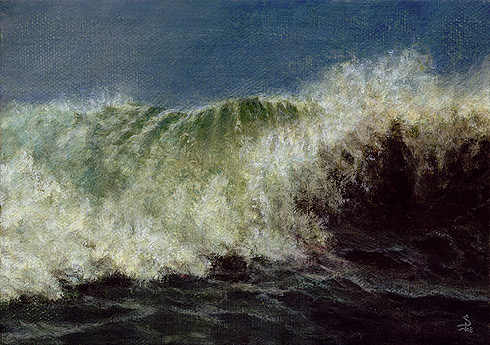
Wave Study, 2008, 5" x 7", Acrylics on Canvas by David Jay Spyker
The Carnegie Center for the Arts/W.R. Monroe Museum utilizes all available exhibition space for a generous showing each year. It also happens that the Carnegie is where I had my first full solo show – at the time, Tom Lowry was the director – so it definitely holds a special spot in my personal artistic history.
The 2009 Regional Juried Arts Show runs January 18 – February 22, and the opening reception and awards ceremony is on Sunday, January 18 from 2-4 pm.
Art Artistic Motivations: Birds Painting Skull
by David Jay Spyker
leave a comment
The Lost
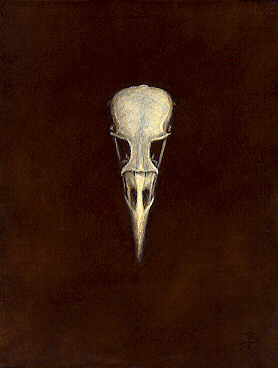
"The Lost", 2000, 5 x 3 3/4 in., Acrylics on Hardboard
In representational art, a man or woman pondering the human skull is used to convey an awareness of mortality, or more accurately, mankind’s awareness of his own mortality. The presence of a human skull in painting is a reminder that each of us is here only for a short while, and that our time is indefinite and unknown.
The bird skull in “The Lost” is meant to remind us of the interconnectedness and mortality of every living being with which we share this ever-shrinking globe. It is tiny, fragile, easily overlooked; and while the bird is living, it is swift and fleeting, impossible to simply grasp in one’s hand.
I found this particular skull in a hedge row in my overgrown back yard. I looked down, and it was just lying there atop a single brown leaf in the midst of a patch of dead leaves, pale and ghostly in the near twilight like someone had carefully placed it there as an offering. I could easily have missed it – and stepped on it – as I crept beneath the tangled branches. I knew I had to paint it.
“The Lost” is a small, simple painting. There is no one to ponder the skull; only the skull – painted in life size – hovers before you, the viewer. You are the philosopher, meant to think over this tiny thing. It is intended to engage you, and make you the human element to this painting.
Some Advice on Artist’s Support Media
I don’t recall where I originally gave the following advice on artist’s supports for painting, but it was in answer to an oil painter seeking a large scale, more rigid alternative to canvas or linen. He was concerned with longevity and cracking. I felt it might be of interest, so I’ve republished it here.
Everything will decay eventually, but a quality Masonite (or “hardboard”, as Masonite is a manufacturer of the product) should be every bit as reliable as any canvas or linen supports. Make sure to fully seal the edges and the back of any hardboard panels. Ideally, the back of any type of panel should be gessoed with the same number of layers as are applied to the front so as to create more even tension on both sides of the support, which will minimize warping. This will also serve to seal the wood materials from the air – ancient Egyptian wood that was painted can be found surviving rather well in tombs, while unpainted wood in the same tombs has rotted terribly. You could go one step further and apply some extra to the back to account for the layers of paint that will be applied to the front.
There is a tiny oil painting in the Art Institute of Chicago which was done on copper sheet. I don’t remember the date off hand, but it was hundreds of years old, and it looked like it was painted yesterday. Aside from potential dents, which will be difficult to remove, copper’s drawback is its weight when used in large sheets. Aluminum is lighter, but it is also much softer than copper.
I have painted on copper, stone, wood panel, birch plywood, hardboard, canvas, linen, and paper; I have also used canvas, linen, and paper mounted on wood and hardboard. The birch plywood actually performs very well, but is very heavy in large sheets. For anything large, I’d recommend you do stick with canvas or linen. I know you said you did not want to do that, but it is still potentially the best choice for large pieces.
Focus instead on proper layering and preparatory techniques for your painting to help prevent any problems that might occur over time. At some point in the future, it will be up to the conservators to ensure the longevity of your work. Existing in museums are hundreds of pieces on canvas that have been transferred to rigid supports. Museum conservators know what they are doing, and once you’re dead (before that actually), your work’s future will be totally beyond your control.
Another thing to consider, if cracking is a nagging worry, would be to try working in acrylics instead.
If you are up for some technical reading on the subject of choosing the proper hardboards as artist’s supports, I recommend the following page: http://www.true-gesso-panels.com/2003_stp_article.htm
“Flow” Wins Award
David Jay Spyker has been awarded The Martin Maddox Prize for Imaginative Realist Painting at the Kalamazoo Area Show for “Flow”, a painting in acrylics on canvas. The prize is named after the artist Martin Maddox – who was a friend of Mr. Spyker – and it has been awarded at the show each year since Maddox’s death in 1997. Martin Maddox was known for the emotive, evocative, and imaginative style of his figurative paintings in oils and pastels.
The Kalamazoo Area Show is an annual regional art competition held at the Kalamazoo Institute of Arts. This year’s installment runs from July 1 – August 26, 2006; the show drew 718 entries (a record number), of which only 158 were accepted for exhibition by juror Tim Lowly. It is a very strong show this year, and is well worth the visit.
Art Exhibitions: Competition Exhibition Painting
by David Jay Spyker
leave a comment
The Painting “Someday” in Battle Creek Competition
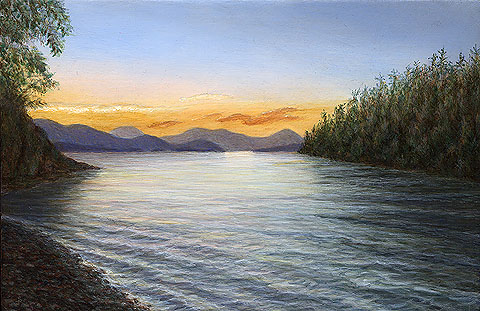
"Someday", by David Jay Spyker, (2005, Acrylics on Board, 4 x 6 in.)
The small painting, “Someday”, is currently on display as part of the 27th Annual Michigan Artists’ Competition at the Art Center of Battle Creek in Battle Creek, Michigan. The show, which includes 55 works by 43 regional artists, was judged by Jane Connell, Director of Collections and Exhibitions/Senior Curator of the Muskegon Museum of Art in Michigan. It runs from June 2 through July 1, 2006.
